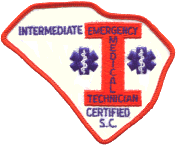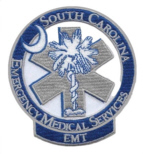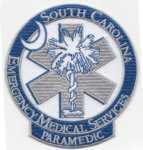
First Responder
Emergency Medical Technician (EMT)
Emergency Medical Technician - Intermediate (EMT-I)
Emergency Medical Technician - Advanced (EMT-P) Paramedic

First
Responder
Emergency Medical Technician (EMT)
Emergency Medical Technician -
Intermediate (EMT-I)
Emergency Medical Technician -
Advanced (EMT-P) Paramedic
|
|
The
First Responder program is designed to train individuals likely be the
first on the scene of an automobile collision to assess the situation
and provide urgent emergency medical care until definitive care arrives. The South Carolina First Responder consists of a revised Department of Transportation's 40-hour First Responder course, along with an additional 4-hour South Carolina EMS-imposed oxygen administration training course. This curriculum provides the student with vital training that will permit the rendering of lifesaving techniques at the roadside. Additional information about First Responders is below. |
This patch is awarded at the completion of the South Carolina Emergency Medical Technician course, Basic level. This course consists of 120 hours of classroom time, 12 hours of hospital training, and a written and skills practical exam. This level of certification is required to be able to perform primary patient care onboard an ambulance in South Carolina. Additional information about EMT's is below. |
|
 |
This
has been changed into the AEMT (Advanced Emergency Medical Technician).
Time and training levels are different than the original EMT-I. We will
update this when the SC AEMT patch is available. This patch is awarded at the completion of the South Carolina Emergency Medical Technician course, Intermediate level. This course follows success completion of the EMT Basic course, and adds an additional 48 hours of material. Additional skills that can be performed include Endotracheal Intubation and administration of selected drugs. Additional information about EMT-I's is below. |
| The Paramedic patch is awarded at the completion of the
South Carolina Emergency Medical Technician course, Advanced level.
This course requires an additional 640 hours of classroom time,
followed by 120 hours of hospital training. Additional skills that can
be performed over the Intermediate level include administration of
up to 40 drugs, Intra-osseous Infusions, Cardiac Monitoring,
Pacing and Defibrillation, and Pleural Decompression of the chest.
Recent changes to the paramedic curriculum have increased the total
course time to over 1,200 hours starting in 2002. Additional information about Paramedics is below. |
|
 | The New Emergency Medical Technician patch is awarded at the completion of the South Carolina Emergency Medical Technician. |
 |
The New Paramedic patch is awarded at the completion of the
South Carolina Emergency Medical Technician course, Advanced level.
This course requires an additional 640 hours of classroom time,
followed by 120 hours of hospital training. Additional skills that can
be performed over the Intermediate level include administration of
up to 40 drugs, Intra-osseous Infusions, Cardiac Monitoring,
Pacing and Defibrillation, and Pleural Decompression of the chest.
Recent changes to the paramedic curriculum have increased the total
course time to over 1,200 hours starting in 2002. Additional information about Paramedics is below. |
| The symbol of the STAR OF LIFE, which is used in the
United States to indicate a provider of emergency care. This symbol was
designed by Leo R. Schwartz, Chief of the EMS Branch of the National
Highway Traffic Safety Administration, in 1973. The symbol commonly
used till that time was the Omaha cross, which is an orange cross
similar to the Red Cross. The Red Cross objected to the similarity, and
NHTSA investigated and determined that a symbol that could be more
easily recognized was needed. In 1977, the Star of Life was registered
as a trademark. More history and meaning behind the Star of Life is available here. |
| First Responder
What is a First Responder? The First Responder program is designed to train individuals likely be the first on the scene of an automobile collision to assess the situation and provide urgent emergency medical care until EMS arrives. The program serves a dual purpose of reducing response times, particularly in rural areas, while reducing the death rate due to highway accident trauma. The program may also reduce the magnitude of injury. Who should be a First Responder? It is a fact that proper and timely rendering of emergency medical care at the scene of an automobile crash can reduce the number of deaths and decrease the level of injuries. Areas that have an inadequate number of EMTs or that have long response times can supplement the EMS system by training personnel outside the system such as police officers, firemen, city and county maintenance workers and other governmental personnel who work on or near roadways. In addition, rescue squad members who are not currently EMTs but perform other duties for the squads, particularly driving the vehicle to the scene, are ideal candidates for First Responder training. What training is required? Training is offered and administered by DHEC's Office of EMS under a grant from South Carolina Department of Public Safety and the National Highway Traffic Safety Administration. Actual course instruction is provided by South Carolina's four EMS Regional Offices. The comprehensive training program includes the revised Department of Transportation's 40-hour First Responder course, along with an additional 4-hour South Carolina EMS-imposed oxygen administration training course. This curriculum provides the student with vital training that will permit the rendering of lifesaving techniques at roadside until EMS arrives. |
| Emergency Medical Technician - Basic (EMT) The EMT-B is the cornerstone of the emergency medical system. All prehospital professionals, regardless of their level of certification, are trained to perform the basic skills first: One-and two-person CPR Splinting of upper and lower extremities Conscious and unconscious infant obstructed airway Fractures/dislocations Conscious and unconscious child and adult obstructed airway Patient assessment Patient lifting Vital signs, including B/P via auscultation and palpation Infant CPR O2 administration Peripheral pulses and pressure points Use of bag-valve-mask resuscitator (1-person and 2-person) Oropharyngeal airway Suction of adult, child and infant Bandage upper and lower extremities Airway maintenance with and without spinal injury precautions Tourniquet Epistaxis control Management of hyperventilation Spinal immobilization (short and long board) Application of pneumatic anti-shock garment (PASG)* Maintenance of intravenous fluid lines Orotracheal intubation* (removed by the State Medical Committe as an EMT skill in 2009) Automatic External Defibrillator (AED)* Sterile suction* EMT-administered medications (O2, activated charcoal*, ipecac*, instant glucose*) EMT patient-assisted medications* (nitroglycerin, epi auto-injectors, prescribed inhalers) The EMT-B course provides candidates with the medical knowledge to permit them to give care to the critically ill and injured at the scene and en route to a medical facility. The courses are taught at local technical colleges, vocational schools, and selected colleges and universities. The 139 hour EMT-B course, is based on the current Department of Transportation (DOT) curriculum. In addition to the 110-hour curriculum of DOT, additional hours are included for advanced airway, CPR, infection control, pneumatic anti-shock garments, and IV maintenance, for a total of 139 hours of didactic and skills instruction. The hours required for this clinical experience are in addition to the 139 required didactic hours and can be served either in an ambulance or a hospital emergency department. During their clinical experience, all candidates must complete five full patient assessments and document these assessments on the state Ambulance Run Reports. |
| Emergency Medical
Technician - Intermediate (EMT-I)
Many emergency medical providers in rural areas saw a need for another level of certification that would give their volunteer personnel an opportunity to learn certain advanced life support skills. The EMT-I course began as a result of this need. The role of the EMT-I is one of authority when working with a EMT-B and one of support when working with a paramedic. EMT-I’s are authorized to perform any of the basic life
support skills. In addition, they may perform the following
intermediate life support skills under the supervision of a medical
control physician: EMT-I’s must also be members of an licensed EMT service that is licensed to provide intermediate extended or advanced life support. The EMT-I course is taught from the Department of Transportation's current intermediate curriculum. The initial course consists of eighty hours of instruction, of which sixty-four hours are theory, and sixteen hours are clinical. |
| Emergency Medical
Technician - Advanced (EMT-P) Paramedic
The EMT-P serves a unique role in the emergency medical services system, functioning as the eyes, ears, and hands of the medical control physician. At the direction of the physician, the EMT-P can perform advanced life support procedures that prior to the mid 1970's were performed only in the emergency department. EMT-P’s are authorized to perform any of the basic and intermediate life support skills. In addition, they may perform the following advanced life support skills under the supervision of a medical control physician. Medication administration techniques: EMT-P’s must be practicing members of an EMS service that is licensed to provide advanced life support. The paramedic course is taught from the Department of Transportation's current paramedic curriculum. The course consists of 424 hours of instruction, of which 212 hours are didactic, 130 hours are clinical, 72 hours are field internship, and 10 hours are testing. Excerpts of the above from the detailed information available on the South Carolina Department of Health and Environmental Control website at http://www.scdhec.com/hr/NewEMS/train.htm For more information about becoming a First Responder, EMT, EMT-I, or Paramedic, contact Don Whiteley at (803) 545-4269, or Arnold Alier at (803) 545-4958. |